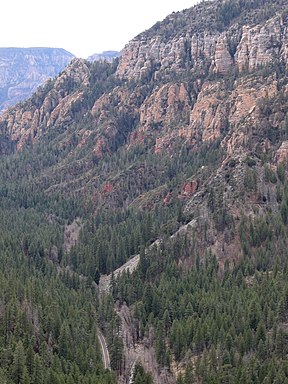Oak Creek Canyon
| Oak Creek Canyon | |
|---|---|
 South view, from above north terminus (Coconino Plateau) Coconino Sandstone cliffs above Hermit Formation,[1] on west canyon wall | |
Location in Arizona, northeast of Verde River | |
| Length | 12 miles (19 km) North–South |
| Width | 0.8 to 2.5 miles (1.3 to 4.0 km) |
| Geography | |
| Coordinates | 34°54′45″N 111°43′37″W / 34.91250°N 111.72694°W |
| Traversed by | Arizona State Route 89A |
| Rivers | Oak Creek |
Oak Creek Canyon is a river gorge located in northern Arizona between the cities of Flagstaff and Sedona. The canyon is often described as a smaller cousin of the Grand Canyon because of its scenic beauty. State Route 89A enters the canyon on its north end via a series of hairpin turns before traversing the bottom of the canyon for about 13 miles (21 km) until the highway enters the town of Sedona.
Geography
Oak Creek Canyon is about 12 miles (19 km) long, ranging in width from 0.8 to 2.5 miles (1.3 to 4.0 km). The depth of the canyon ranges from 800 to 2,000 feet (240 to 610 m). However, due to the
Oak Creek
Oak Creek, a tributary of the Verde River, flows along the bottom of the canyon, and is one of the few perennial streams in the high desert region of northern Arizona. Oak Creek is largely responsible for carving the modern Oak Creek Canyon, although movement along the Oak Creek Fault, a 30-mile (48 km) long north–south normal fault line, is thought to have played a role as well. Oak Creek has an elevation of 4,300 feet (1,300 m) just north of Sedona to 6,000 feet (1,800 m) at the northern terminus of the canyon.[citation needed]
Oak Creek enters more open country below Sedona. It meanders past the communities of
Geology

Geologic evidence suggests the formation of an ancestral Oak Creek Canyon along the Oak Creek Fault about eight to ten
The spectacularly eroded walls of the canyon are formed mostly of
Recreation

Oak Creek Canyon is located within the
2014 Slide Fire
On May 20, 2014, at around 4 PM, a wildfire was reported just north of Slide Rock State Park. The fire was 100% contained on June 4, 2014, with 21,227 acres burned. Total personnel included over 1,230 firefighters, 50 crews, 29 engines, and 9 helicopters.[7]
After the fire, the Sedona Fire District installed nine
See also
References
- ^ Chronic, Halka. Roadside Geology of Arizona, c. 1983, 23rd printing, 321 pages, (US 89A Flagstaff to Arizona), pp. 233–236, map ref, p. 192.
- ^ TopoQuest – USGS Cornville (AZ) Topo Map
- ^ "Brins Fire-June 2006". U.S. Forest Service, Coconino National Forest. Retrieved 2006-11-09.
- ^ a b c Ranney, Wayne D.R. (May 1998). "Geologic Road Log for U.S. Route 89A through Oak Creek Canyon". Geologic Excursions in Northern and Central Arizona. Department of Geology, Northern Arizona University. pp. 177–179.
- ISBN 0-89886-730-4.
- ^ "West Fork of Oak Creek Trail". U.S. Forest Service, Coconino National Forest. Retrieved 2006-11-09.
- ^ "Arizona Coconino National Forest, Slide Fire". INCIWEB: Incident Information System. 2015. Retrieved October 18, 2015.
- Arizona Fishin' Holes : A Guide to Popular Fishing Waters and Facilities in Arizona. Phoenix, AZ: Arizona Game and Fish Department. 2007.

